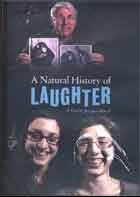
The Natural History of Laughter 2011
Distributed by Icarus Films, 32 Court St., 21st Floor, Brooklyn, NY 11201; 800-876-1710
Produced by Arte France
Directed by Jacques Mitsch
DVD, color, 48 min., In English and French with English subtitles
Sr. High - General Adult
Animal Behavior, Biology, Psychology, Social Sciences
Date Entered: 12/05/2012
Reviewed by Wendy Highby, University of Northern ColoradoThe Natural History of Laughter is an engaging documentary about the use of laughter as a tool to comparatively study the evolution of animals and human beings. It explores social neuroscience, a relatively new interdisciplinary field concerning the biological mechanisms underlying social processes and behavior. The film features interviews with six scientists. Director Jacques Mitsch calls the six iconoclasts “the inventors of laughter science” and says they “demonstrate that laughter is a determining factor in understanding mankind and its evolution.” The featured scientists are Robert Provine, neuroscientist and psychology professor at the University of Maryland, Baltimore County, U.S.A.; Jan A.R.A.M. van Hooff, ethologist and socio-ecologist at the Burgers Zoo, Arnhem, The Netherlands; Marina Davila-Ross, comparative and evolutionary psychologist at the University of Portsmouth, U.K.; Jaak Panksepp, neurobiologist at Washington State University, Pullman, U.S.A.; Giacomo Rizzolatti, neurophysiologist and Vittorio Gallese, cognitive neuroscientist both at the University of Parma, Italy.
The narrative structure of the film is spot-on; it eases the viewer into the subject by beginning with human laughter. Dr. Provine, the author of the seminal book Laughter: A Scientific Investigation (2000), introduces the topic of laughter science. The camera follows him from the classroom lecture hall in Baltimore to the campus cafeteria, where he observes the social behavior of humans. The film then moves to animal behavior at Burgers Zoo in Arnhem, The Netherlands. The voiceover narrator explains the need to comparatively study ape and human behavior. Dr. van Hooff, an animal behavior expert at the zoo, introduces the concept of evolutionary history and describes his innovative, systematic observations of a chimpanzee colony that began in 1971. He explains how he discovered the disparate origins and significance of the primate behaviors of laughter and smiling. Halfway through the film, a third scientist is added to the mix; Dr. Davila-Ross, a chimp vocalization expert, joins Dr. van Hooff at the Burgers Zoo. The two scientists are shown conducting tickling experiments with chimpanzees, through which they collect acoustic data used to study vocal evolution. The footage of their interaction with a baby chimpanzee is particularly transfixing.
The film’s locale shifts back to the United States, to Washington State. Dr. Panksepp is the fourth scientist in the film, and arguably the most controversial, as it is unusual for scientists to openly speak about the emotions of animals. He was investigating the playfulness of rats when he made the “spectacular discovery” of rat laughter. Their ultrasonic chuckles are inaudible to human ear. Dr. Panksepp hopes that the research results in psychopharmacological applications for humans, such as the development of new, more effective anti-depressant drugs. Lastly, the film moves to Italy to address the social facets of laughter and the research into its contagious and imitative aspects. The discovery of mirror neurons at the University of Parma is explained by Professors Giacomo RIzzolatti and Vittorio Gallese. It was their ethological approach to the study of motor neurons in the macaque monkey that resulted in the landmark discovery.
Filmmaker Jacques Mitsch has captured something quintessential about the scientific process in this film about non-conforming “laughter scientists.” This is perhaps best summed up in this pithy quote from Dr. Panksepp about the nature of scientific inquiry: “science never deals in proof; science deals in evidence.” The documentary is both intellectually stimulating and emotionally satisfying. It has the potential to be a vocational motivator for high school students, inspiring them to pursue science. For undergraduates, it could support the study of the biological basis of social behavior and boost understanding of concepts in social neuroscience, evolutionary psychology, animal behavior studies, and related subjects. And the film could appeal to the graduate student and professional audience, as they will relate to its revelation of the scientific research process. The film offers clarity for the neophyte science student and complexity for the aspiring or practicing scientist. Because of the interdisciplinary nature of social neuroscience, the documentary has broad potential application across the curriculum, from philosophy to general science. It would be quite effective as a teaching tool about observation, empiricism, and the scientific process. It should be of particular relevance for students of animal behavior (ethology), biology, cognitive sciences, communication, neurosciences, and social psychology.